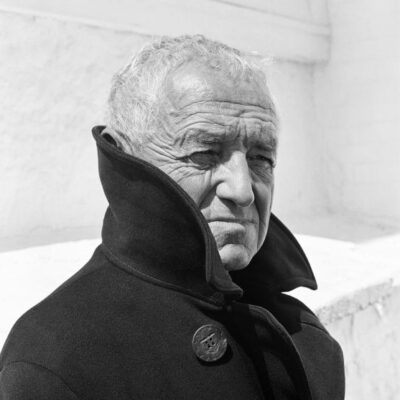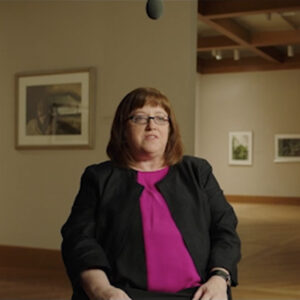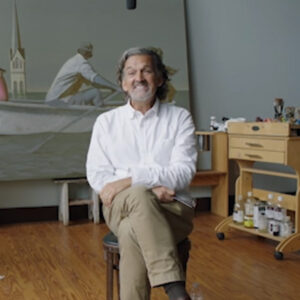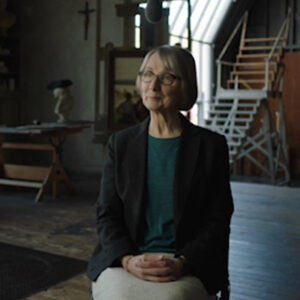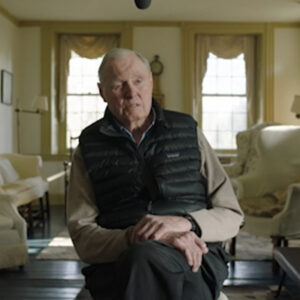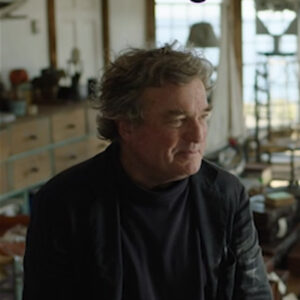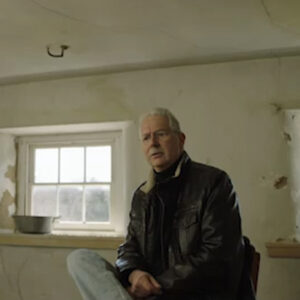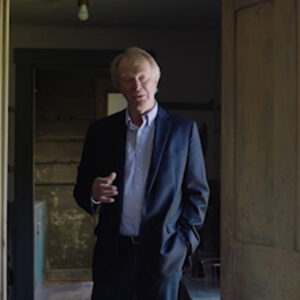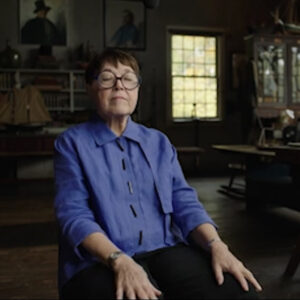Speaker When I was presenting wife’s work at the Philadelphia Museum of Art and in 2005 and six, we we tried to recover the strength of his work for a new generation to introduce and reassess the work. And I think one of the missions was to show him as a modern artist, as a person from the 20th century who was really grappling with not just the formal qualities of art. That is the abstraction that’s in his work, the sense of two dimensional design, the sense of surface texture, all these things that really make him into a modern painter, but also the toughness of the subject matter. This is work that is dark, that is heavy. It’s not lightweight, sentimental painting. This is really strong, modern work.
Speaker It is because people say, look, you have the barn painter, and that’s right, yeah, no, not. Do it, you did a great job. OK, so Phil, would you want to take the still camera and do a couple of shots for me? Yes, we’re here. Shane, are you comfortable with that? That’s great trick.
Speaker You can come home and we’d love some Tom. OK, but.
Speaker While we do want to tell you I’m just taking a look at the lens.
Speaker You’ve never seen it, but, oh, oh, that’s OK.
Speaker And the next question was actually that one. There we go.
Speaker I do have one more question. Sorry, can we go to one more question?
Speaker What was and who was dating, what was his day like? How do you feel these days?
Speaker Andrew wife got up in the morning and went out and made drawing’s.
Speaker And he came home for dinner.
Speaker He spent the entire day walking, exploring, sketching, thinking. I think he was an artist 24 hours a day.
Speaker That’s amazing, isn’t it?
Speaker It was an incredible life. It just it dazzles me every time I think about it.
Speaker He was lucky and he didn’t have to, I guess, because, you know, there’s no financial worries.
Speaker Was just no, it was just about what was interesting.
Speaker Yeah, no, he was protected so that he could be an artist, which is just extraordinary. He was so fortunate. We are so fortunate.
Speaker All right, I’m finally done for real, for real money to be turned off and back here, at least give me 10 seconds. Of course.
Speaker There is a stillness. Yeah, but I can hear it, maybe it’s this light, I can hear mechanical noise.
Speaker All right, red lights are on here, so, you know, I was just saying as a filmmaker, it took me years to realize that, like, what I’m searching for is like the strength in other people and sort of find out if I have that in myself. And I’m wondering if there was any kind of mirror that he was trying to look at in terms of the kind of family Nielsen family are comparing it to his family or what? Because I guess they’re a different class of people, you know, it’s sort of like looking at but I think he’s also looking at something he’s responding to in.
Speaker I have no doubt in my and that’s a really good observation. I mean, I think he was really fascinated by Karl Kerner. I think he identified with Karl Kerner in a way in much the same way that he tried to get inside the head of a lot of his sisters, Karl Kerner, in a way, took the place of his father. His father was killed on the on the railroad crossing just right down the hill.
Speaker And so this farm became also a landscape of grief and then a second home for wives. But Carl was very different from Nancy. So to just say that he was a father figure was, I think, too simple. Carl was really a figure of fascination for him, as well as a sturdy peasant stock guy, you know, farmer, no nonsense. A man of the land. Carl, is a man of, you know, hog butchering and hunting guns and knives and truly manly representative. And so I think why it just loved him as a specimen, you know, to just examine how he lived his life. He also was a World War One machine gunner. And that was totally part of why its imagination, the violence that lurked in his past, that then somehow enacted itself in Karl as a hunter or as a hog butcher, that that that subversive that latent violence fascinated why if he always loved to sort of poke at the dark side. And so I think he saw Carl as a figure of fascination.
Speaker Well, speaking of Colin, speaking of this room, can we talk about Groundhog Day and sort of take it apart a little bit and how you sort of have grown to know it?
Speaker Groundhog Day was begun in this room and it started with him having lunch here and just seeing the fall of light, the sunshine across the wallpaper that just struck his imagination. And as he himself later said, I left the room and went up on the hill and sat on the hill and looked down on the house and started to make sketches from memory. So there you go. It he never sat in this room and painted the view out the window. He left the room and thought about it from a distance. So after imagining the whole concept of the table and the luncheon, he came back. By this time, Carl had gone and he started to sketch and Mrs. Kerner seated by the windowsill and the family dog Nellie and that whole little circle of Nellie, the dog and the wife and the wife, they became part of this galaxy of the painting that he gradually exemplified. And that’s another part of why a story is that he circles the subject, thinks about it from afar, roams around. He made dozens and dozens of drawings as he tried to sort of think about what is the key image here. Some of them included and some of them included the dog. And I went away. The dog went away. Things started to get simple and it boiled down to just the empty table waiting for Carl to come home. But you feel the presence of Carl that he is waiting for Carl or that he has just stepped away. That’s that sense of imminence in the painting. And then there’s this strange story of the dog. You know, the scary German shepherd, the wife admitted was a nasty and nasty dog. It was a guard dog and only came into the house really when the weather was cold. That dog, who’s also a figure of latent violence, latent threat, shown sleeping and docile, but nonetheless is got this banked violence in that dog, then gets transformed in this mysterious here’s the magic, mysterious way into this log outside the window with this jagged, jagged teeth. This is this is why its own interpretation. I am not making this up. He described how the story of the law sort of transformed itself and the dog was no longer needed because the violence was now vested in this log. So if you looking out the window at the painting, there’s this scary log staring at you that looks like it’s about to come charging into the kitchen. That sense of violence in the buried dog and in the Carl corner who’s not there anymore is part of the restlessness of this painting, because on the one hand, it’s so serene, it looks so tranquil. It’s just like a lovely midwinter day. And then the more you look at it, the more there are these unsettling aspects. It can’t really be explained. And they’re part of that distillation of how he came to make the image.
Speaker That was beautiful.
Speaker I was having a tough race and do you see people at your at the images of people observing the painting that way?
Speaker And I wonder if you’ve ever observed people sort of saying, oh, all the time, I think why is pictures always captured people? They stare at them and and just roam around in them. When we did the exhibition at the museum, it actually was not unusual to find people in tears in front of the paintings and paintings that weren’t overtly sad, you know, paintings that didn’t have any actual superficial story of grief or tragedy. They just opened up people to emotion in a way. And I think that’s one of the powers of his paintings. We had a memory book at the end of the exhibition and people would comment that this reminded me of my grandmother or I began to miss my childhood home. You know, it opened up memories in people. And I think that’s one of the powers in his work, is that the emotion that he brings into the picture allows people to unlock emotion of their own.
Speaker I think you can tell me we’re back, Mogens, we’re back. Thank you.
Speaker So we’ve talked about tax fraud. Do you are you comfortable talking about me and what you’re what? Let’s see what happens. Like what? Why was I mean, and what gave him.
Speaker The wife family has an old old roots in New England whose father was born in Massachusetts, and so they were used to going north and visiting family. And so the pattern of traveling to Maine was something established early in his childhood. But he made Maine his sort of alternate life. His pattern of changing from winter and summer between Maine and transport became really the rhythm of his universe. And between these two landscapes, he just found an infinity of choices. Maine was different for for the coastline, for the quality of the landscape, for the architecture. And of course, he found a fabulous collection of people to paint.
Speaker What he did here. Hmm.
Speaker So let’s talk about mean early on, because we have those early watercolors that were a little different than the rest of the work could set that that know offered him as a young artist.
Speaker Mm hmm.
Speaker His first watercolors in Maine are fabulous and splashy. They are Wyeth. Channeling Winslow, Homer and Maine also meant Winslow Homer to him. Homer was one of his heroes. Edward Hopper also painted in Maine. And so we can see the influence of Hopper’s watercolors in those early works. But it’s really about Winslow Homer, the coastline, the rocks, the surf, and then this expressionistic handling. So it’s sort of like he’s taking Homer and pushing Homer into the 20th century, being much more explosive, more emotional even than Homer, but in that same tradition of responding to the American landscape.
Speaker In the previous count, not this one that the one right before the U.S. did a lovely set up about the seasons and the locations, was I sort of retread that and just start with that idea because it was really winter and fall here, wasn’t it?
Speaker And then he said we could start with that idea. I think that’s a pretty. I appreciate that. Mm hmm. Mm hmm.
Speaker Chadds Ford is the landscape of the fall and winter for him. He loved winter. He loves snow. He liked the bareness of the landscape and the quality that you could see the bones in the in the landscape here and then Maine with summer. Maine was all about the sun and the wind and the ocean. And so you can see the two sides of his work is also the two sides of the calendar for him.
Speaker And let’s talk about the color, the color world has color choices because they change from those temperatures, from those early watercolors, very colorful and his decision to sort of even out of power. And that’s true for both locations, isn’t it?
Speaker Mm hmm. Mm hmm. In the middle of his career.
Speaker Why it’s really known for a kind of somber palette, lots of OCA’s earth tones. And I think it was a deliberate choice, actually, for him to restrain his palette and narrow it down. His earlier work in the 30s is much brighter, a lot more red and blue.
Speaker And I think he made a very conscious choice to go to these earth tones, to ochre and gray, but then become a kind of signal palette for him. I don’t know whether it’s a mood thing, you know, because that that quality of that palette is very identifiable with a slightly depressed and melancholy quality.
Speaker But I also think it’s very modern because it pulls the values of the picture together into a single family. The pictures become flatter and they become more abstract. So I think by taking color out, he’s also, in a way, becoming more modern and interesting.
Speaker And then what was there a critical response to that choice, that sort of. Become a topic of discussion about his work, or is it just sort of this and I don’t know.
Speaker I don’t know. That’s a good question to ask Wanda Corn.
Speaker I’ll do that. I don’t know the answer to that.
Speaker And can we talk about. Some of the rebirth of our interest in India, I think was happening to him now in terms of scholarship and art history, art historians, how the. The fact that. He’s sort of shedding a little bit of the weight that he wore when he while he was living.
Speaker I don’t know whether you want me to get into the hug, the hug? Yeah, yeah, I think Wyeth was making a comeback. He was becoming more respectable in the 1980s as realism returned, as different ways of painting suddenly became possible. Narrative returns, subject matter returns to painting in the 1980s. And I think people were looking harder at Wyeth. Unfortunately, what happened in the middle of the 80s was the hilgert, the Helga scandal, which in a way just threw him off the tracks. And many people who were starting to reconsider his work just walked away. So in a way, it’s set back the reconsideration of his work for another 15 years. It took some time for people to get past that Helga story and think again about his pictures. So when you get to the turn of the 21st century, which is when the Philadelphia Museum of Art and the High Museum in Atlanta were doing the retrospective, I think there was enough distance on the scandal, shall we say, of the 1980s, that we could come coolly back to the work and think very hard about the meaning of his career. And what we really wanted to do in that survey was reposition him as a 20th century painter, reconsider how modern his work is, how powerful it is, and think about him as a man really situated in his culture, not a reactionary, but actually a modern thinking, emotional artist, one of the best of his generation. So the intention in our exhibition was to give him that new look and reassure people that it was his paintings were wonderful, that they were powerful, that he was a serious and important painter.
Speaker So you’ve just said the paintings were wonderful, they were powerful, let’s make it present presentence. The paintings are wonderful.
Speaker Mm hmm. Mm hmm. Well, yes, it’s true. I’m thinking about the year 2006. Yeah. So what would you say? That all over again with a well, present tense. Yeah. Well, where we are now. The world where you are.
Speaker I think since your wife’s death, it’s it’s liberated people to reconsider his work, we began this process, I think, of reconsideration with the retrospective in 2005 and six. But now I think we see a whole new generation of scholars coming to the subject of Wyeth and being very open ended. Now about the analysis of his work and its interpretation. I think we’ve moved beyond the the sort of easy opposition of realism and abstraction, which I think was the story back in the 1960s when when he was cast into the rear guard. And I think it’s now possible to see him as just a different way of being modern. That’s that’s the message, I think, of the new research and analysis of his work, thinking about the messages, thinking about his technique, thinking about the way he organized and composed his work. It’s really very modern and very, very powerful.
Speaker Why was that?
Speaker Well, the thing is, Carol, I think it was a scandal, partly because he’d kept all of this work secret and everybody was titillated by the idea that he had a whole body of work that he was not telling his wife about, not telling the rest of the world about, and that there were a lot of nudes involved in a beautiful young woman. So that in itself was a kind of soap opera. That story was then twisted into a manipulation that he was accused of having done the whole thing in order to create headlines, and that the secret was not a secret. It was a conspiracy. So they were layer upon layer here of of scandal that I think was distasteful for people. Even his own admirers were unhappy about this. Certainly it was an explosion within the family that was very unhappy. And so there were just many, many realms of unhappiness and sadness.
Speaker It’s been it’s been one of my great pleasure to sort of revisit the Huckabee as I was younger at the time. And the whole idea was that, you know, he painted a nude woman. So it’s been a pleasure to revisit some of the one of her floating things called Blackfield. Yeah, there’s some amazing stuff there. Oh, yes. Can you talk about that? Like how maybe we can look at them again without all that Michigan’s.
Speaker The hell the pictures have some extraordinary, extraordinary, beautiful paintings, they are not only fabulous in terms of their technique and the quality of the of the painting, but the composition, the subject matter. They are really striking pictures. So I think there’s some of his finest paintings. And now that we’re now at a distance 20 years, 25 years away, I think we can see the excellence in these paintings. There’s still, of course, an erotic story that’s unavoidable. And so that’s that’s potent in these pictures. But I think we can also see them as great paintings.
Speaker Are there any that come to mind that you would put in that category?
Speaker Oh, the one that you’ve mentioned about the black velvet, pink black velvet is lovely, but there’s also some some simple portraits like braids, which is just such a beautiful painting and so tender, and the painting of her braids and of her eyelashes. It it’s it’s an extraordinary picture that just makes you catch your breath.
Speaker Great. I agree with you on that. And those are the two, that’s enough. Mm hmm. So here’s a very bizarre question. But what has you about his paintings? What knocks you out now?
Speaker Well, as an art historian, I am just stunned by his technical expertise.
Speaker He is such a fabulous draftsman. He can really draw. He can really handle watercolor painting. So that always leaves me breathless. But it’s not just about technique. And he himself actually was a little bit annoyed, by the way, in which people would focus on his technique, as if that was really the only thing he brought to the table is his subject matter is really amazing. And so a picture like Groundhog Day, which you can just look at again and again, you never get tired of looking at that painting. It’s not about a wizard of the brush, really. It’s about the magic of the painting. It’s about his choices as an artist, about the revelry that’s in this picture. These are the things that make you go back and look at a painting again and again. It’s that deep, deep content.
Speaker That fabulous. The the south, the Whitney headlines are on the block, you know, he really has breaks in attendance records. Can you talk about the PMA experience and what kind of response you had from the general public and what you witnessed happening today? You mentioned some people claim that it was a very popular experience.
Speaker Well, the thing about Wyeth is that he is an artist who can reach out and attract a very diverse audience. So people come to his work for all different reasons, admire it for different reasons. In the past, that was seen as somewhat a disparaging idea, as if popular, popular attention was somehow a sign that the work was not profound, that it was superficial in some way. And I think what we’ve discovered is why is audiences huge?
Speaker It’s educated, it’s smart. The kind of comments that we got in our visitor response book or so intelligent, there’s so profound. And so the audience here is not witless. It is a thinking audience and the power of the work and its appeal to people from all different walks of life, many different educational backgrounds, has shown the staying power here.
Speaker Most people know Andrew Wyeth from Christina’s world.
Speaker In fact, recently it’s been named and oh my gosh, yes, Kellyanne Conway.
Speaker Oh my God, what happened when you started to flip out? Yes, yes, yes, yes.
Speaker Well, I you know, I was offended by the photograph of her, like in her shoes kneeling on the couch. Right. I’m going like, what a jerk. Right.
Speaker So then to then put that image into Christina’s world, it was like all the things about Kellyanne Conway that I don’t like magnified, but he wasn’t running.
Speaker That was a Christian as well of him as Christina with the White House, as the Olsen House. I didn’t see that. I wonder if you could just sort of talk about that and what we like about it and sort of bring it back to a painting about with all these qualities we’ve been discussing in.
Speaker But it also has a huge connection with at least the American spirit, and so I don’t really I’d love to sort of dig into that a little bit with you.
Speaker Christina’s world is a picture that’s actually kind of hard to look at anymore because it’s become such an icon that to come to it fresh is almost impossible. Now, we have decades of seeing it parodied and caricatured. And, you know, it’s it’s a common it’s a picture like American Gothic that has just become part of the American iconography. But that, in a way, is a sign of its strength, that over decades it people come back to it generation after generation and find it haunting, find it powerful, even picture people who don’t really know the story of Christina. And so the ability for people to project onto that picture, to read into it, to make it their own is a sign of its power. So I, of course, think it’s a fantastic painting. I know so much about the Olsson’s. I know about Christina, so I know its place in his work and how powerful it was to him as an expression of who Christina was. But it’s also interesting to stand back and just see, you know, any average person come up to that painting and react to it without knowing the whole Christina story. And they still find it riveting. They find it dreamlike. They they go into that picture and make it their own. That’s that’s a powerful picture. It’s a phenomenon. Yeah.
Speaker So, Kathy, I’ve got to ask you to introduce yourself to me at the beginning of this interview. I mean, who you are and what you do. That’s something that I may not use, but it’s OK right now.
Speaker OK, I’m Kathleen Foster and I’m the senior curator of American Art at the Philadelphia Museum of Art.

